Workplace Absenteeism Report: Exploring Causes, Impact & Remedies
VerifiedAdded on 2023/06/15
|9
|2079
|190
Report
AI Summary
This report examines workplace absenteeism, a common issue faced by employers, focusing on its causes, impact, and potential remedies. The causes of workplace absenteeism include bullying and harassment, excessive workload, depression, illness and injuries, and partial shifts. Absenteeism negatively impacts organizational productivity, profitability, and team performance. Remedies discussed include employee motivation using Herzberg's two-factor theory, considering individual behavior and personality when assigning tasks, improving communication between managers and subordinates, positive reinforcement through attendance policies and perks, and flexible scheduling to balance work and personal life. The report concludes that minimizing workplace absenteeism is essential for achieving organizational goals and enhancing employee satisfaction and productivity. Desklib offers similar solved assignments and past papers for students.

Organization Behavior
Paraphrase This Document
Need a fresh take? Get an instant paraphrase of this document with our AI Paraphraser
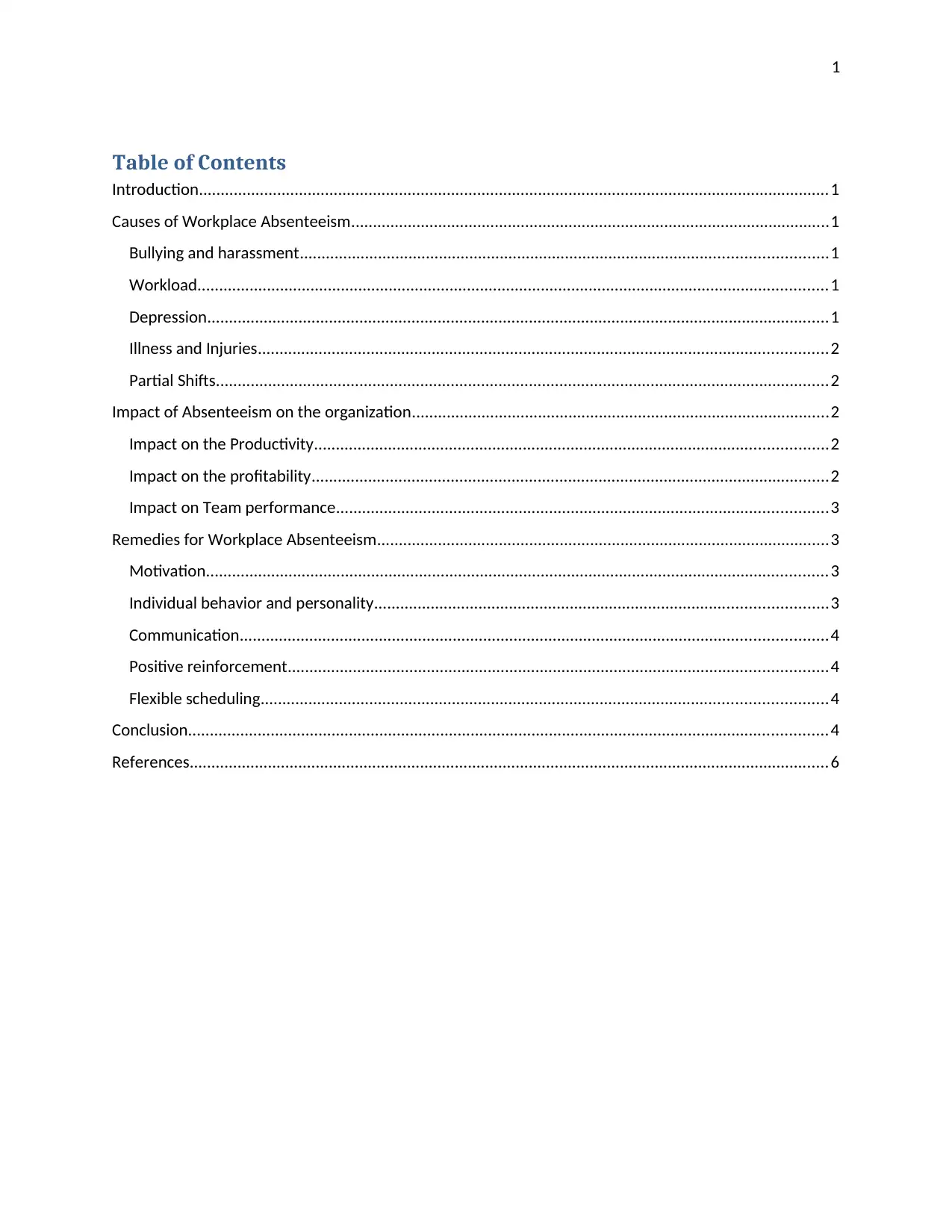
1
Table of Contents
Introduction.................................................................................................................................................1
Causes of Workplace Absenteeism..............................................................................................................1
Bullying and harassment.........................................................................................................................1
Workload.................................................................................................................................................1
Depression...............................................................................................................................................1
Illness and Injuries...................................................................................................................................2
Partial Shifts.............................................................................................................................................2
Impact of Absenteeism on the organization................................................................................................2
Impact on the Productivity......................................................................................................................2
Impact on the profitability.......................................................................................................................2
Impact on Team performance.................................................................................................................3
Remedies for Workplace Absenteeism........................................................................................................3
Motivation...............................................................................................................................................3
Individual behavior and personality........................................................................................................3
Communication.......................................................................................................................................4
Positive reinforcement............................................................................................................................4
Flexible scheduling..................................................................................................................................4
Conclusion...................................................................................................................................................4
References...................................................................................................................................................6
Table of Contents
Introduction.................................................................................................................................................1
Causes of Workplace Absenteeism..............................................................................................................1
Bullying and harassment.........................................................................................................................1
Workload.................................................................................................................................................1
Depression...............................................................................................................................................1
Illness and Injuries...................................................................................................................................2
Partial Shifts.............................................................................................................................................2
Impact of Absenteeism on the organization................................................................................................2
Impact on the Productivity......................................................................................................................2
Impact on the profitability.......................................................................................................................2
Impact on Team performance.................................................................................................................3
Remedies for Workplace Absenteeism........................................................................................................3
Motivation...............................................................................................................................................3
Individual behavior and personality........................................................................................................3
Communication.......................................................................................................................................4
Positive reinforcement............................................................................................................................4
Flexible scheduling..................................................................................................................................4
Conclusion...................................................................................................................................................4
References...................................................................................................................................................6
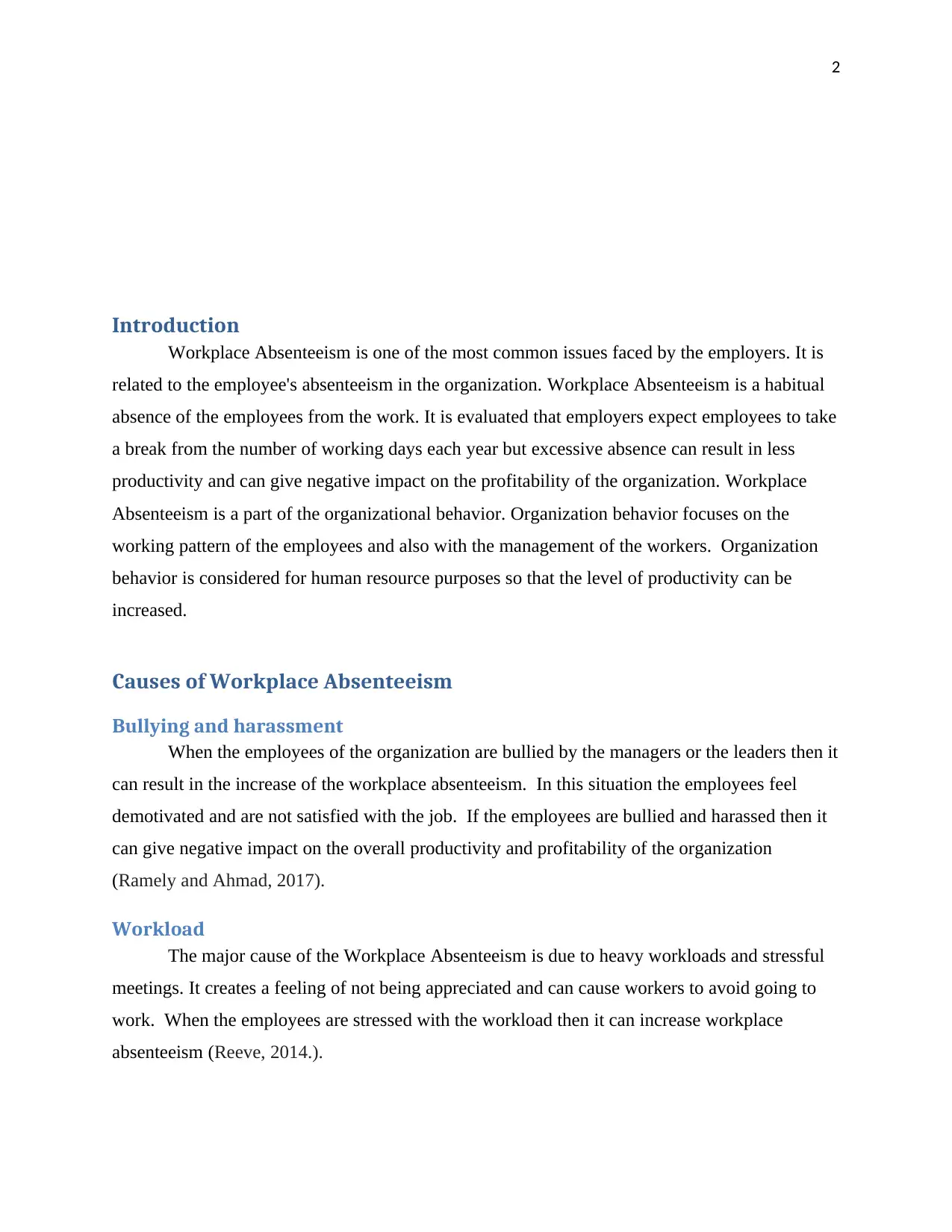
2
Introduction
Workplace Absenteeism is one of the most common issues faced by the employers. It is
related to the employee's absenteeism in the organization. Workplace Absenteeism is a habitual
absence of the employees from the work. It is evaluated that employers expect employees to take
a break from the number of working days each year but excessive absence can result in less
productivity and can give negative impact on the profitability of the organization. Workplace
Absenteeism is a part of the organizational behavior. Organization behavior focuses on the
working pattern of the employees and also with the management of the workers. Organization
behavior is considered for human resource purposes so that the level of productivity can be
increased.
Causes of Workplace Absenteeism
Bullying and harassment
When the employees of the organization are bullied by the managers or the leaders then it
can result in the increase of the workplace absenteeism. In this situation the employees feel
demotivated and are not satisfied with the job. If the employees are bullied and harassed then it
can give negative impact on the overall productivity and profitability of the organization
(Ramely and Ahmad, 2017).
Workload
The major cause of the Workplace Absenteeism is due to heavy workloads and stressful
meetings. It creates a feeling of not being appreciated and can cause workers to avoid going to
work. When the employees are stressed with the workload then it can increase workplace
absenteeism (Reeve, 2014.).
Introduction
Workplace Absenteeism is one of the most common issues faced by the employers. It is
related to the employee's absenteeism in the organization. Workplace Absenteeism is a habitual
absence of the employees from the work. It is evaluated that employers expect employees to take
a break from the number of working days each year but excessive absence can result in less
productivity and can give negative impact on the profitability of the organization. Workplace
Absenteeism is a part of the organizational behavior. Organization behavior focuses on the
working pattern of the employees and also with the management of the workers. Organization
behavior is considered for human resource purposes so that the level of productivity can be
increased.
Causes of Workplace Absenteeism
Bullying and harassment
When the employees of the organization are bullied by the managers or the leaders then it
can result in the increase of the workplace absenteeism. In this situation the employees feel
demotivated and are not satisfied with the job. If the employees are bullied and harassed then it
can give negative impact on the overall productivity and profitability of the organization
(Ramely and Ahmad, 2017).
Workload
The major cause of the Workplace Absenteeism is due to heavy workloads and stressful
meetings. It creates a feeling of not being appreciated and can cause workers to avoid going to
work. When the employees are stressed with the workload then it can increase workplace
absenteeism (Reeve, 2014.).
⊘ This is a preview!⊘
Do you want full access?
Subscribe today to unlock all pages.

Trusted by 1+ million students worldwide
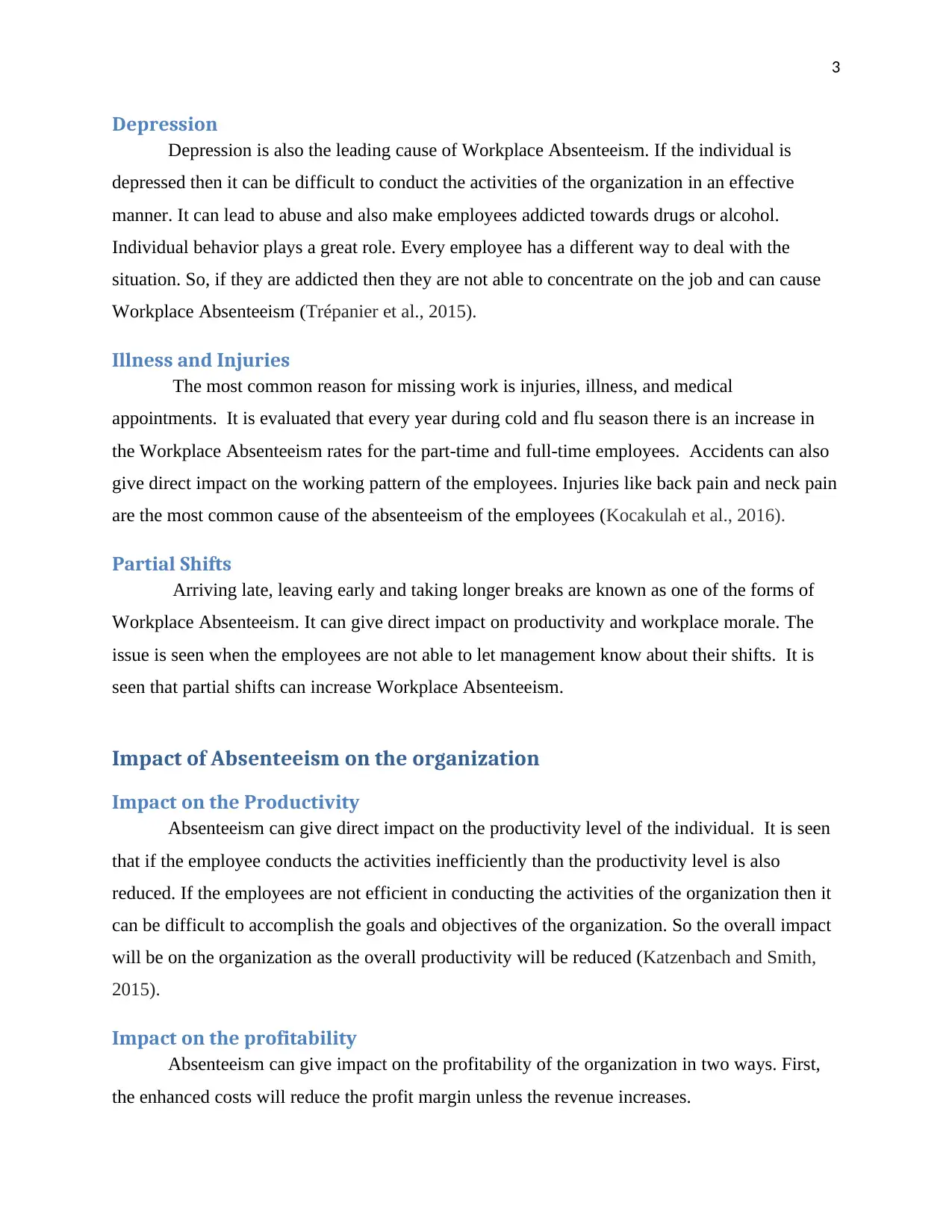
3
Depression
Depression is also the leading cause of Workplace Absenteeism. If the individual is
depressed then it can be difficult to conduct the activities of the organization in an effective
manner. It can lead to abuse and also make employees addicted towards drugs or alcohol.
Individual behavior plays a great role. Every employee has a different way to deal with the
situation. So, if they are addicted then they are not able to concentrate on the job and can cause
Workplace Absenteeism (Trépanier et al., 2015).
Illness and Injuries
The most common reason for missing work is injuries, illness, and medical
appointments. It is evaluated that every year during cold and flu season there is an increase in
the Workplace Absenteeism rates for the part-time and full-time employees. Accidents can also
give direct impact on the working pattern of the employees. Injuries like back pain and neck pain
are the most common cause of the absenteeism of the employees (Kocakulah et al., 2016).
Partial Shifts
Arriving late, leaving early and taking longer breaks are known as one of the forms of
Workplace Absenteeism. It can give direct impact on productivity and workplace morale. The
issue is seen when the employees are not able to let management know about their shifts. It is
seen that partial shifts can increase Workplace Absenteeism.
Impact of Absenteeism on the organization
Impact on the Productivity
Absenteeism can give direct impact on the productivity level of the individual. It is seen
that if the employee conducts the activities inefficiently than the productivity level is also
reduced. If the employees are not efficient in conducting the activities of the organization then it
can be difficult to accomplish the goals and objectives of the organization. So the overall impact
will be on the organization as the overall productivity will be reduced (Katzenbach and Smith,
2015).
Impact on the profitability
Absenteeism can give impact on the profitability of the organization in two ways. First,
the enhanced costs will reduce the profit margin unless the revenue increases.
Depression
Depression is also the leading cause of Workplace Absenteeism. If the individual is
depressed then it can be difficult to conduct the activities of the organization in an effective
manner. It can lead to abuse and also make employees addicted towards drugs or alcohol.
Individual behavior plays a great role. Every employee has a different way to deal with the
situation. So, if they are addicted then they are not able to concentrate on the job and can cause
Workplace Absenteeism (Trépanier et al., 2015).
Illness and Injuries
The most common reason for missing work is injuries, illness, and medical
appointments. It is evaluated that every year during cold and flu season there is an increase in
the Workplace Absenteeism rates for the part-time and full-time employees. Accidents can also
give direct impact on the working pattern of the employees. Injuries like back pain and neck pain
are the most common cause of the absenteeism of the employees (Kocakulah et al., 2016).
Partial Shifts
Arriving late, leaving early and taking longer breaks are known as one of the forms of
Workplace Absenteeism. It can give direct impact on productivity and workplace morale. The
issue is seen when the employees are not able to let management know about their shifts. It is
seen that partial shifts can increase Workplace Absenteeism.
Impact of Absenteeism on the organization
Impact on the Productivity
Absenteeism can give direct impact on the productivity level of the individual. It is seen
that if the employee conducts the activities inefficiently than the productivity level is also
reduced. If the employees are not efficient in conducting the activities of the organization then it
can be difficult to accomplish the goals and objectives of the organization. So the overall impact
will be on the organization as the overall productivity will be reduced (Katzenbach and Smith,
2015).
Impact on the profitability
Absenteeism can give impact on the profitability of the organization in two ways. First,
the enhanced costs will reduce the profit margin unless the revenue increases.
Paraphrase This Document
Need a fresh take? Get an instant paraphrase of this document with our AI Paraphraser
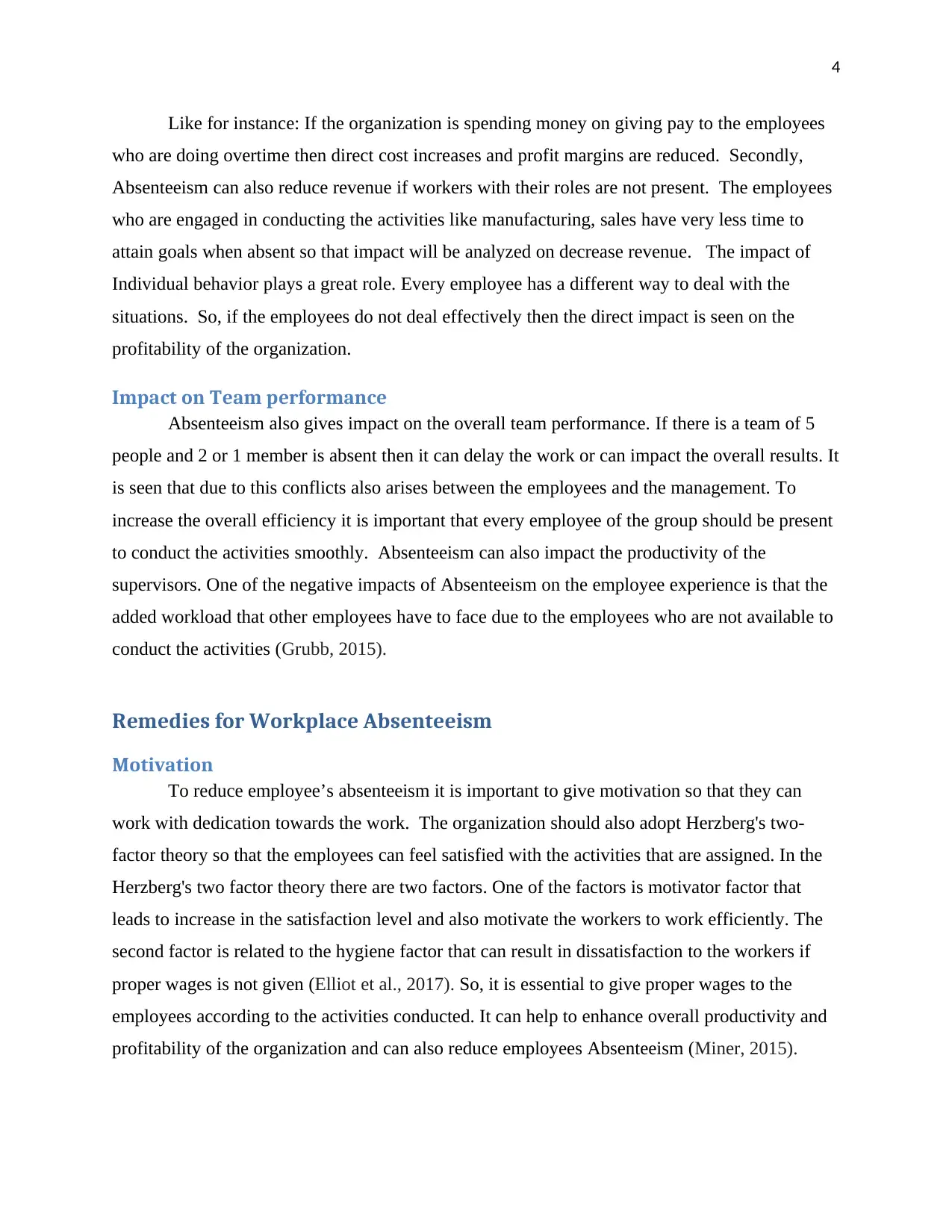
4
Like for instance: If the organization is spending money on giving pay to the employees
who are doing overtime then direct cost increases and profit margins are reduced. Secondly,
Absenteeism can also reduce revenue if workers with their roles are not present. The employees
who are engaged in conducting the activities like manufacturing, sales have very less time to
attain goals when absent so that impact will be analyzed on decrease revenue. The impact of
Individual behavior plays a great role. Every employee has a different way to deal with the
situations. So, if the employees do not deal effectively then the direct impact is seen on the
profitability of the organization.
Impact on Team performance
Absenteeism also gives impact on the overall team performance. If there is a team of 5
people and 2 or 1 member is absent then it can delay the work or can impact the overall results. It
is seen that due to this conflicts also arises between the employees and the management. To
increase the overall efficiency it is important that every employee of the group should be present
to conduct the activities smoothly. Absenteeism can also impact the productivity of the
supervisors. One of the negative impacts of Absenteeism on the employee experience is that the
added workload that other employees have to face due to the employees who are not available to
conduct the activities (Grubb, 2015).
Remedies for Workplace Absenteeism
Motivation
To reduce employee’s absenteeism it is important to give motivation so that they can
work with dedication towards the work. The organization should also adopt Herzberg's two-
factor theory so that the employees can feel satisfied with the activities that are assigned. In the
Herzberg's two factor theory there are two factors. One of the factors is motivator factor that
leads to increase in the satisfaction level and also motivate the workers to work efficiently. The
second factor is related to the hygiene factor that can result in dissatisfaction to the workers if
proper wages is not given (Elliot et al., 2017). So, it is essential to give proper wages to the
employees according to the activities conducted. It can help to enhance overall productivity and
profitability of the organization and can also reduce employees Absenteeism (Miner, 2015).
Like for instance: If the organization is spending money on giving pay to the employees
who are doing overtime then direct cost increases and profit margins are reduced. Secondly,
Absenteeism can also reduce revenue if workers with their roles are not present. The employees
who are engaged in conducting the activities like manufacturing, sales have very less time to
attain goals when absent so that impact will be analyzed on decrease revenue. The impact of
Individual behavior plays a great role. Every employee has a different way to deal with the
situations. So, if the employees do not deal effectively then the direct impact is seen on the
profitability of the organization.
Impact on Team performance
Absenteeism also gives impact on the overall team performance. If there is a team of 5
people and 2 or 1 member is absent then it can delay the work or can impact the overall results. It
is seen that due to this conflicts also arises between the employees and the management. To
increase the overall efficiency it is important that every employee of the group should be present
to conduct the activities smoothly. Absenteeism can also impact the productivity of the
supervisors. One of the negative impacts of Absenteeism on the employee experience is that the
added workload that other employees have to face due to the employees who are not available to
conduct the activities (Grubb, 2015).
Remedies for Workplace Absenteeism
Motivation
To reduce employee’s absenteeism it is important to give motivation so that they can
work with dedication towards the work. The organization should also adopt Herzberg's two-
factor theory so that the employees can feel satisfied with the activities that are assigned. In the
Herzberg's two factor theory there are two factors. One of the factors is motivator factor that
leads to increase in the satisfaction level and also motivate the workers to work efficiently. The
second factor is related to the hygiene factor that can result in dissatisfaction to the workers if
proper wages is not given (Elliot et al., 2017). So, it is essential to give proper wages to the
employees according to the activities conducted. It can help to enhance overall productivity and
profitability of the organization and can also reduce employees Absenteeism (Miner, 2015).
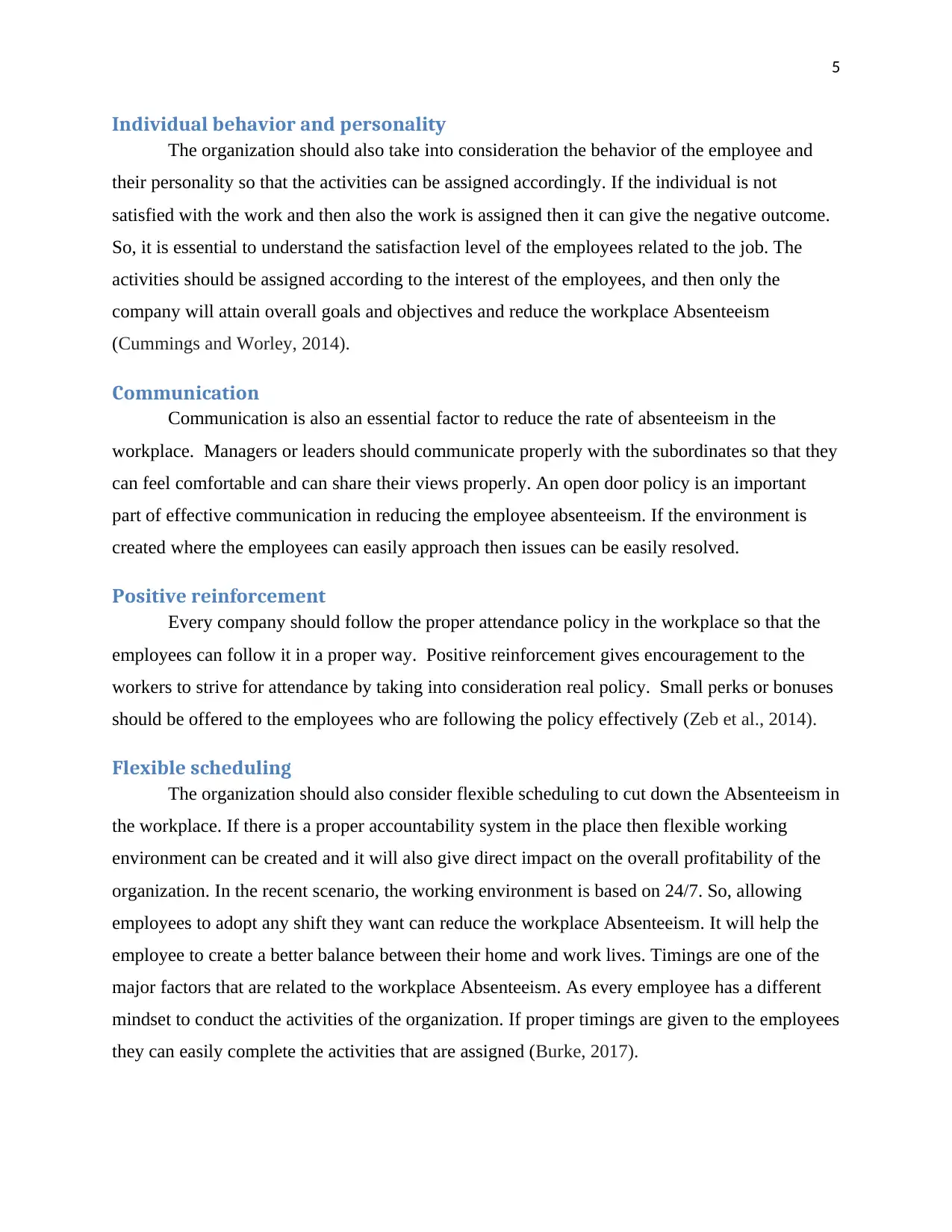
5
Individual behavior and personality
The organization should also take into consideration the behavior of the employee and
their personality so that the activities can be assigned accordingly. If the individual is not
satisfied with the work and then also the work is assigned then it can give the negative outcome.
So, it is essential to understand the satisfaction level of the employees related to the job. The
activities should be assigned according to the interest of the employees, and then only the
company will attain overall goals and objectives and reduce the workplace Absenteeism
(Cummings and Worley, 2014).
Communication
Communication is also an essential factor to reduce the rate of absenteeism in the
workplace. Managers or leaders should communicate properly with the subordinates so that they
can feel comfortable and can share their views properly. An open door policy is an important
part of effective communication in reducing the employee absenteeism. If the environment is
created where the employees can easily approach then issues can be easily resolved.
Positive reinforcement
Every company should follow the proper attendance policy in the workplace so that the
employees can follow it in a proper way. Positive reinforcement gives encouragement to the
workers to strive for attendance by taking into consideration real policy. Small perks or bonuses
should be offered to the employees who are following the policy effectively (Zeb et al., 2014).
Flexible scheduling
The organization should also consider flexible scheduling to cut down the Absenteeism in
the workplace. If there is a proper accountability system in the place then flexible working
environment can be created and it will also give direct impact on the overall profitability of the
organization. In the recent scenario, the working environment is based on 24/7. So, allowing
employees to adopt any shift they want can reduce the workplace Absenteeism. It will help the
employee to create a better balance between their home and work lives. Timings are one of the
major factors that are related to the workplace Absenteeism. As every employee has a different
mindset to conduct the activities of the organization. If proper timings are given to the employees
they can easily complete the activities that are assigned (Burke, 2017).
Individual behavior and personality
The organization should also take into consideration the behavior of the employee and
their personality so that the activities can be assigned accordingly. If the individual is not
satisfied with the work and then also the work is assigned then it can give the negative outcome.
So, it is essential to understand the satisfaction level of the employees related to the job. The
activities should be assigned according to the interest of the employees, and then only the
company will attain overall goals and objectives and reduce the workplace Absenteeism
(Cummings and Worley, 2014).
Communication
Communication is also an essential factor to reduce the rate of absenteeism in the
workplace. Managers or leaders should communicate properly with the subordinates so that they
can feel comfortable and can share their views properly. An open door policy is an important
part of effective communication in reducing the employee absenteeism. If the environment is
created where the employees can easily approach then issues can be easily resolved.
Positive reinforcement
Every company should follow the proper attendance policy in the workplace so that the
employees can follow it in a proper way. Positive reinforcement gives encouragement to the
workers to strive for attendance by taking into consideration real policy. Small perks or bonuses
should be offered to the employees who are following the policy effectively (Zeb et al., 2014).
Flexible scheduling
The organization should also consider flexible scheduling to cut down the Absenteeism in
the workplace. If there is a proper accountability system in the place then flexible working
environment can be created and it will also give direct impact on the overall profitability of the
organization. In the recent scenario, the working environment is based on 24/7. So, allowing
employees to adopt any shift they want can reduce the workplace Absenteeism. It will help the
employee to create a better balance between their home and work lives. Timings are one of the
major factors that are related to the workplace Absenteeism. As every employee has a different
mindset to conduct the activities of the organization. If proper timings are given to the employees
they can easily complete the activities that are assigned (Burke, 2017).
⊘ This is a preview!⊘
Do you want full access?
Subscribe today to unlock all pages.

Trusted by 1+ million students worldwide
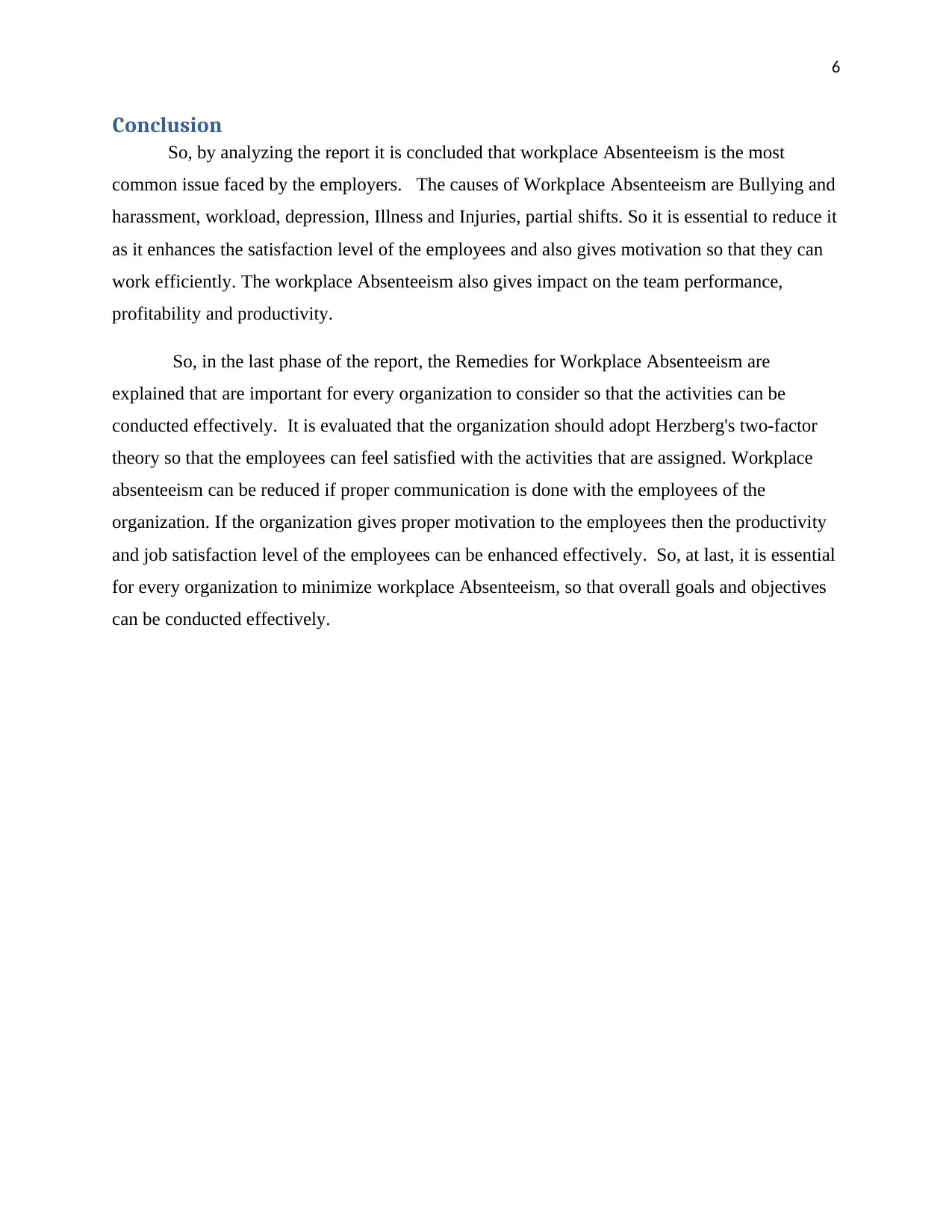
6
Conclusion
So, by analyzing the report it is concluded that workplace Absenteeism is the most
common issue faced by the employers. The causes of Workplace Absenteeism are Bullying and
harassment, workload, depression, Illness and Injuries, partial shifts. So it is essential to reduce it
as it enhances the satisfaction level of the employees and also gives motivation so that they can
work efficiently. The workplace Absenteeism also gives impact on the team performance,
profitability and productivity.
So, in the last phase of the report, the Remedies for Workplace Absenteeism are
explained that are important for every organization to consider so that the activities can be
conducted effectively. It is evaluated that the organization should adopt Herzberg's two-factor
theory so that the employees can feel satisfied with the activities that are assigned. Workplace
absenteeism can be reduced if proper communication is done with the employees of the
organization. If the organization gives proper motivation to the employees then the productivity
and job satisfaction level of the employees can be enhanced effectively. So, at last, it is essential
for every organization to minimize workplace Absenteeism, so that overall goals and objectives
can be conducted effectively.
Conclusion
So, by analyzing the report it is concluded that workplace Absenteeism is the most
common issue faced by the employers. The causes of Workplace Absenteeism are Bullying and
harassment, workload, depression, Illness and Injuries, partial shifts. So it is essential to reduce it
as it enhances the satisfaction level of the employees and also gives motivation so that they can
work efficiently. The workplace Absenteeism also gives impact on the team performance,
profitability and productivity.
So, in the last phase of the report, the Remedies for Workplace Absenteeism are
explained that are important for every organization to consider so that the activities can be
conducted effectively. It is evaluated that the organization should adopt Herzberg's two-factor
theory so that the employees can feel satisfied with the activities that are assigned. Workplace
absenteeism can be reduced if proper communication is done with the employees of the
organization. If the organization gives proper motivation to the employees then the productivity
and job satisfaction level of the employees can be enhanced effectively. So, at last, it is essential
for every organization to minimize workplace Absenteeism, so that overall goals and objectives
can be conducted effectively.
Paraphrase This Document
Need a fresh take? Get an instant paraphrase of this document with our AI Paraphraser
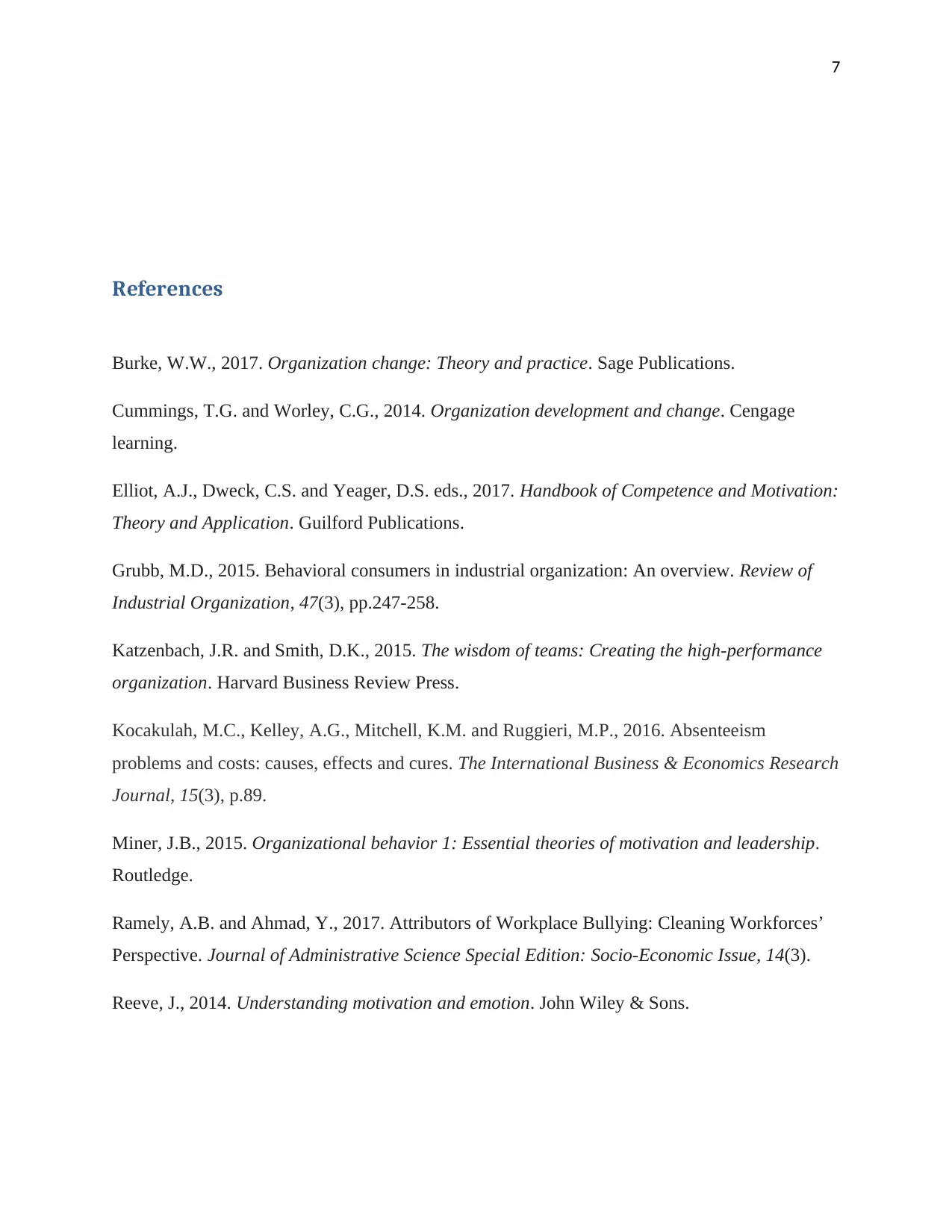
7
References
Burke, W.W., 2017. Organization change: Theory and practice. Sage Publications.
Cummings, T.G. and Worley, C.G., 2014. Organization development and change. Cengage
learning.
Elliot, A.J., Dweck, C.S. and Yeager, D.S. eds., 2017. Handbook of Competence and Motivation:
Theory and Application. Guilford Publications.
Grubb, M.D., 2015. Behavioral consumers in industrial organization: An overview. Review of
Industrial Organization, 47(3), pp.247-258.
Katzenbach, J.R. and Smith, D.K., 2015. The wisdom of teams: Creating the high-performance
organization. Harvard Business Review Press.
Kocakulah, M.C., Kelley, A.G., Mitchell, K.M. and Ruggieri, M.P., 2016. Absenteeism
problems and costs: causes, effects and cures. The International Business & Economics Research
Journal, 15(3), p.89.
Miner, J.B., 2015. Organizational behavior 1: Essential theories of motivation and leadership.
Routledge.
Ramely, A.B. and Ahmad, Y., 2017. Attributors of Workplace Bullying: Cleaning Workforces’
Perspective. Journal of Administrative Science Special Edition: Socio-Economic Issue, 14(3).
Reeve, J., 2014. Understanding motivation and emotion. John Wiley & Sons.
References
Burke, W.W., 2017. Organization change: Theory and practice. Sage Publications.
Cummings, T.G. and Worley, C.G., 2014. Organization development and change. Cengage
learning.
Elliot, A.J., Dweck, C.S. and Yeager, D.S. eds., 2017. Handbook of Competence and Motivation:
Theory and Application. Guilford Publications.
Grubb, M.D., 2015. Behavioral consumers in industrial organization: An overview. Review of
Industrial Organization, 47(3), pp.247-258.
Katzenbach, J.R. and Smith, D.K., 2015. The wisdom of teams: Creating the high-performance
organization. Harvard Business Review Press.
Kocakulah, M.C., Kelley, A.G., Mitchell, K.M. and Ruggieri, M.P., 2016. Absenteeism
problems and costs: causes, effects and cures. The International Business & Economics Research
Journal, 15(3), p.89.
Miner, J.B., 2015. Organizational behavior 1: Essential theories of motivation and leadership.
Routledge.
Ramely, A.B. and Ahmad, Y., 2017. Attributors of Workplace Bullying: Cleaning Workforces’
Perspective. Journal of Administrative Science Special Edition: Socio-Economic Issue, 14(3).
Reeve, J., 2014. Understanding motivation and emotion. John Wiley & Sons.
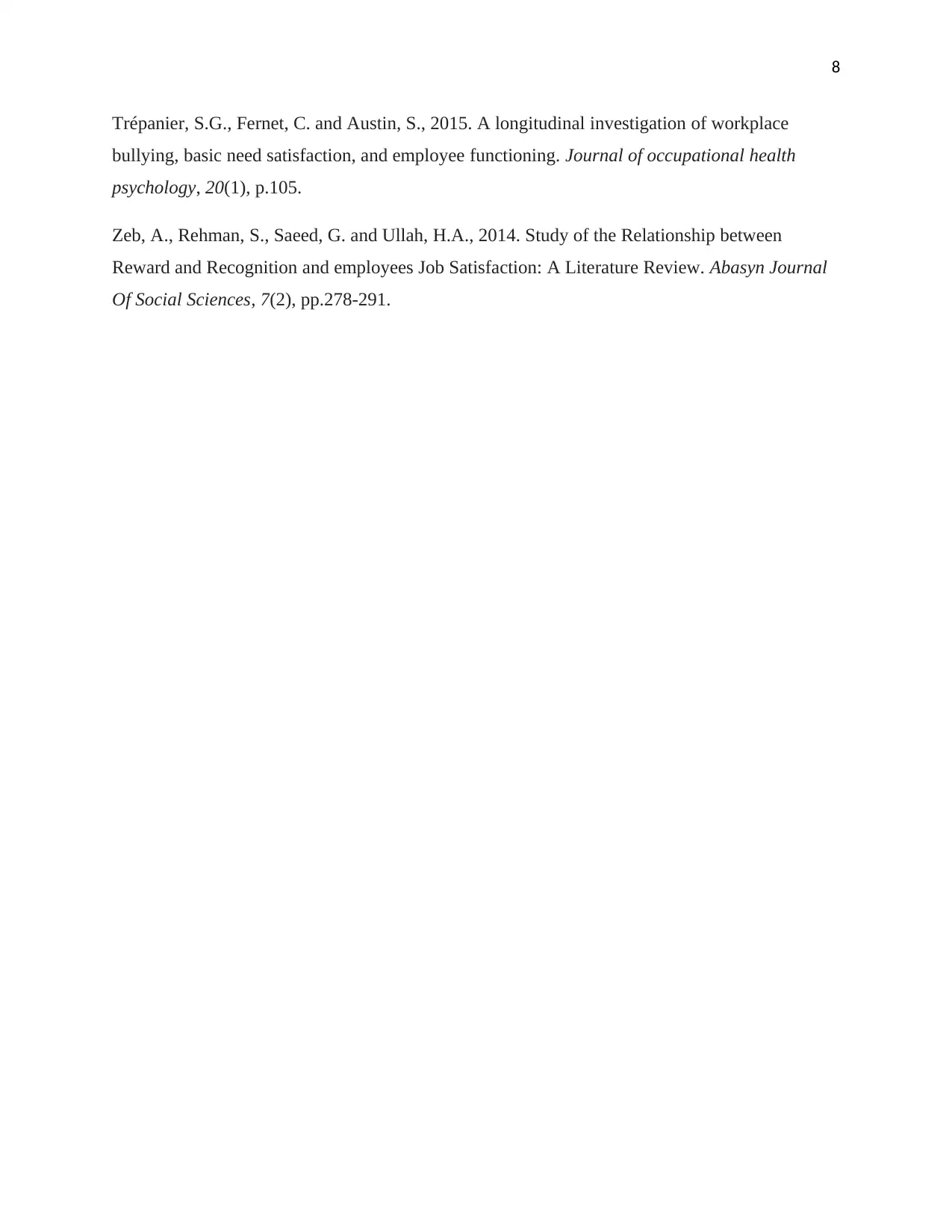
8
Trépanier, S.G., Fernet, C. and Austin, S., 2015. A longitudinal investigation of workplace
bullying, basic need satisfaction, and employee functioning. Journal of occupational health
psychology, 20(1), p.105.
Zeb, A., Rehman, S., Saeed, G. and Ullah, H.A., 2014. Study of the Relationship between
Reward and Recognition and employees Job Satisfaction: A Literature Review. Abasyn Journal
Of Social Sciences, 7(2), pp.278-291.
Trépanier, S.G., Fernet, C. and Austin, S., 2015. A longitudinal investigation of workplace
bullying, basic need satisfaction, and employee functioning. Journal of occupational health
psychology, 20(1), p.105.
Zeb, A., Rehman, S., Saeed, G. and Ullah, H.A., 2014. Study of the Relationship between
Reward and Recognition and employees Job Satisfaction: A Literature Review. Abasyn Journal
Of Social Sciences, 7(2), pp.278-291.
⊘ This is a preview!⊘
Do you want full access?
Subscribe today to unlock all pages.

Trusted by 1+ million students worldwide
1 out of 9
Related Documents
Your All-in-One AI-Powered Toolkit for Academic Success.
+13062052269
info@desklib.com
Available 24*7 on WhatsApp / Email
![[object Object]](/_next/static/media/star-bottom.7253800d.svg)
Unlock your academic potential
Copyright © 2020–2025 A2Z Services. All Rights Reserved. Developed and managed by ZUCOL.





